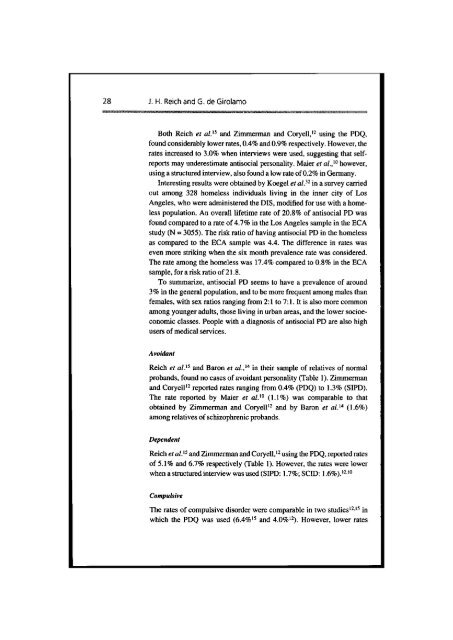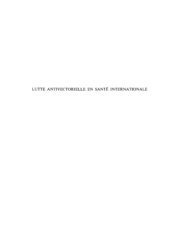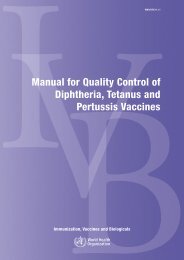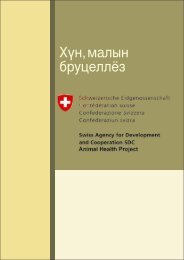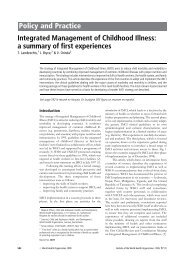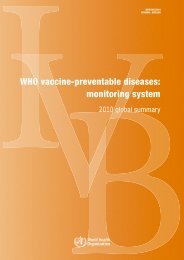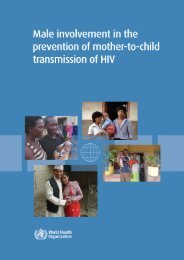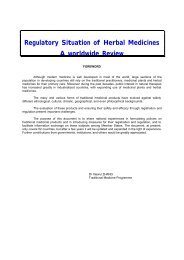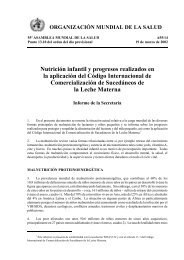IPDE - Extranet Systems - World Health Organization
IPDE - Extranet Systems - World Health Organization
IPDE - Extranet Systems - World Health Organization
You also want an ePaper? Increase the reach of your titles
YUMPU automatically turns print PDFs into web optimized ePapers that Google loves.
28 J. H. Reich and G. de Girolarno<br />
Both Reich er al.Is and Zimmerman and Coryell,12 using the PDQ,<br />
found considerably lower rates, 0.4% and 0.9% respectively. However, the<br />
rates increased to 3.0% when interviews were used, suggesting that selfreports<br />
may underestimate antisocial personality. Maier et a1.,I0 however,<br />
using a structured interview, also found a low rate of 0.2% in Germany.<br />
Interesting results were obtained by Koegel et al.'2 in a survey canied<br />
out among 328 homeless individuals living in the inner city of Los<br />
Angeles, who were administered the DIS, modified for use with a homeless<br />
population. An overall lifetime rate of 20.8% of antisocial PD was<br />
found compared to a rate of 4.7% in the Los Angeles sample in the ECA<br />
study (N = 3055). The risk ratio of having antisocial PD in the homeless<br />
as compared to the ECA sample was 4.4. The difference in rates was<br />
even more striking when the six month prevalence rate was considered.<br />
The rate among the homeless was 17.4% compared to 0.8% in the ECA<br />
sample, for ariskratio of 21.8.<br />
To summarize, antisocial PD seems to have a prevalence of around<br />
3% in the general population, and to be more frequent among males than<br />
females, with sex ratios ranging from 2:l to 7:l. It is also more common<br />
among younger adults, those Living in urban areas, and the lower socioeconomic<br />
classes. People with a diagnosis of antisocial PD are also high<br />
users of medical services.<br />
Reich et al.lS and Baron er al.,14 in their sample of relatives of normal<br />
probands, found no cases of avoidant personality (Table 1). Zimmerman<br />
and Coryell12 reported rates ranging from 0.4% (PDQ) to 1.3% (SIF'D).<br />
The rate reported by Maier er al.lo (1.1%) was comparable to that<br />
obtained by Zimmerman and Coryell12 and by Baron er ol.l4 (1.6%)<br />
among relatives of schizophrenic probands.<br />
Dependent<br />
Reich et al.15 and Zimmerman and C~ryell,~~ using the PDQ, reported rates<br />
of 5.1% and 6.7% respectively (Table 1). However, the rates were lower<br />
when a structured interview was used (SIPD: 1.7%; SCID: 1 .6%).12,L0<br />
Compulsive<br />
The rates of compulsive disorder were comparable in two studie~l~.~~ in<br />
which the PDQ was used (6.4%15 and 4.0%LZ). However, lower rates


